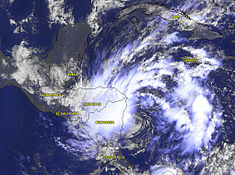Tropical Storm Katrina (1999)
| Tropical Storm ( SSHWS ) | ||
|---|---|---|
| Katrina over Nicaragua | ||
| Emergence | October 27, 1999 | |
| resolution | November 1, 1999 | |
|
Peak wind speed |
|
|
| Lowest air pressure | 999 mbar ( hPa ; 29.5 inHg ) | |
| dead | No | |
| Property damage | US $ 9,900 (1999) | |
|
Affected areas |
Nicaragua , Honduras , Belize , Yucatan Peninsula | |
| Season overview: 1999 Atlantic hurricane season |
||
The Tropical Storm Katrina was a weak tropical cyclone at the end of the Atlantic hurricane 1999 season . Katrina was the eleventh named storm of the season.
Katrina formed over the southwestern Caribbean Sea and was briefly a tropical storm. The system spent most of its existence as a tropical depression, mostly over land. It crossed Central America exactly a year after catastrophic Hurricane Mitch , but did little damage.
Storm course
The system emerged from a weak cold front that slowly moved in the western Caribbean in the fourth week of October 1999. The cold front dissolved, but over the next few days a weak low pressure area took over their space. On October 27, a movement of circulation was detected north of Panama and the system gradually became better organized. A reconnaissance plane took off into the area on the afternoon of October 28 and detected a well-developed circulation near the ground east of Bluefields , Nicaragua . Therefore the system was declared Tropical Depression Fifteen.
The system was not well organized and the influence of the mountainous landscape of Central America held back any potential development. Strong wind shear due to a high pressure gully at altitude also prevented the system from developing as it approached the Nicaraguan coast. In spite of everything, the convection increased briefly on the afternoon of October 29th and the low pressure area was therefore upgraded to Tropical Storm Katrina by the National Hurricane Center . After only six hours of tropical storm status, the system reached the mainland south of Puerto Cabezas in Nicaragua and the storm weakened again to a tropical low.
After that initial land contact, the low remained ill-organized as it migrated northwest, mostly over the mainland. The low pressure system managed to make its way across Nicaragua and Honduras and entered the Gulf of Honduras late on October 30th as a weak tropical low with winds of 45 km / h and a center of circulation . Even though Katrina was above the water again, the low failed to regain its strength and was still a tropical low when it reached the mainland for the second time on the morning of October 31 at the southeastern tip of the Yucatán . This then moved slowly over the central area of the Yucatán and became weaker when another cold front approached from the Gulf of Mexico . The system was slowly absorbed by the cold front when Katrina reached the Gulf on the morning of November 1st and completely dissolved in the afternoon.
Preparations and implications
Although Katrina was a weak storm, forecasters have been quite nervous about the system because Central America was devastated by Hurricane Mitch exactly a year earlier. There were justified fears of further flash floods and landslides in the Central American highlands. Immediately after the tropical depression was declared as such, the authorities issued a tropical storm warning for Nicaragua, which shortly afterwards extended to the Colombian island of San Andrés .
All in all, the damage caused by Katrina was minimal, with fewer landslides and minor flooding as the storm hit Central America. It is estimated that between 250 and 375 mm of rain fell as a result of Katrina, with 91 mm of rainfall observed within six hours on the island of San Andres, east of Nicaragua. No reports of personal injury have been reported in connection with Tropical Storm Katrina.
Due to the lack of significant damage, the Katrina name was not deleted and reused during the 2005 Atlantic hurricane season , but was then deleted and replaced with Katia due to the catastrophic aftermath of Hurricane Katrina .
Individual evidence
- ↑ a b c d e National Hurricane Center: Preliminary Report: Tropical Storm Katrina . NOAA. 1999. Retrieved March 16, 2007.
- ↑ a b National Hurricane Center: Tropical Depression Fifteen Advisory # 1 . NOAA. 1999. Retrieved March 16, 2007.
- ↑ a b National Hurricane Center: Tropical Depression Fifteen Discussion # 2 . NOAA. 1999. Retrieved March 16, 2007.
- ^ National Hurricane Center: Tropical Depression Fifteen Discussion # 4 . NOAA. 1999. Retrieved March 16, 2007.
- ^ National Hurricane Center: Tropical Storm Katrina Discussion # 5 . NOAA. 1999. Retrieved March 16, 2007.
- ^ National Hurricane Center: Tropical Depression Katrina Discussion # 11 . NOAA. 1999. Retrieved March 16, 2007.
- ^ National Hurricane Center: Tropical Depression Katrina Discussion # 14 . NOAA. 1999. Retrieved March 16, 2007.
- ↑ a b USA Today: Katrina a very short-lived storm . Gannett Company. 1999. Retrieved March 16, 2007.
- ^ NOAA News: Atlantic Hurricane 1999 Season Summary . NOAA. 1999. Retrieved March 16, 2007.
Web links
- NHC's Preliminary Report on Tropical Storm Katrina

